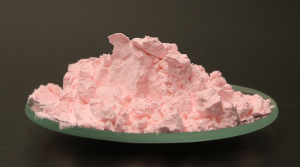Erbium Oxide Properties

Erbium Oxide which has a pink color with a cubic crystal structure, is synthesized from the metal erbium. Erbium metal tarnishes slowly in air. Erbiumburns readily to form Erbium Oxide. Erbium oxide is insoluble in water and soluble in mineral acids. Er2O3 readily absorb moisture and carbon dioxide from the atmosphere.
It can react with acids to form the corresponding Erbium (III) salts. For example, with hydrochloric acid, the oxide follows the reaction Er2O3 + 6 HCl → 2 ErCl3 + 3 H2O to form erbium chloride.
One interesting property of erbium oxides is their ability to up convert energy. Energy up conversion takes place when infrared or visible radiation, low energy light, is converted to ultraviolet or violet radiation higher energy light via multiple transfer or absorption of energy.
Applications of Erbium Oxide Nanoparticles/Nanopowder

The applications of Erbium Oxide nanoparticles/nanopowder are varied due to their electrical, optical and photoluminescence properties. Nanoscale materials doped with Er+3 are of much interest because they have special particle-size-dependent optical and electrical properties. Erbium oxide doped nanoparticle/nanopowder materials can be dispersed in glass or plastic for display purposes, such as display monitors. The spectroscopy of Er+3 electronic transitions in host crystals lattices of nanoparticles/nanopowder combined with ultrasonically formed geometries in aqueous solution of carbon nanotubes is of great interest for synthesis of photoluminescence nanoparticles/ nanopowder in ‘green’ chemistry. Erbium Oxidenanoparticles are among the most important rare earth metals used in biomedicine. The photoluminescence property of erbium oxide nanoparticles/nanopowder on carbon nanotubes
Technical Properties of Our Erbium Oxide (Er2O3) Nanoparticles/Nanopowder, 8-90 nm, Purity 99.95%, Cubic Product
| Purity % | 99.95 |
| Color | pink |
| AVERAGE PARTICLE SIZE (nm): | 8-90 |
| Morphology | nearly spherical |
| SPECIFIC SURFACE AREA (m2/g): | >50 |
| Bulk Density (g/cm3) | 0,5 |
| True Density (g/cm3) | 8 |
You may find Erbium Oxide (Er2O3) Nanoparticles/Nanopowder, 8-90 nm, Purity 99.95%, Cubic by clicking the link below:
Comments
Post a Comment